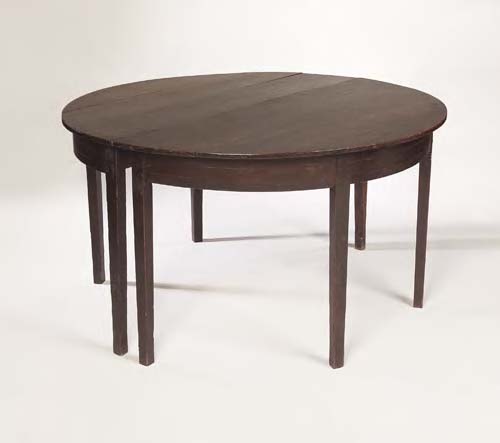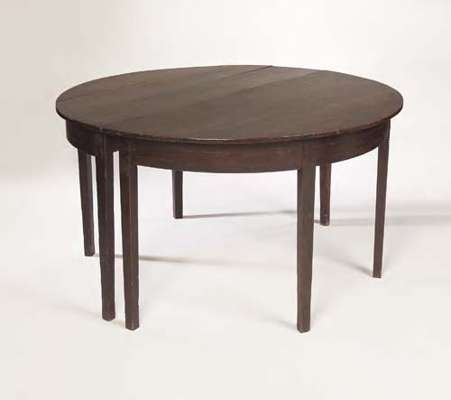
Lot 403

The Nile Tables A pair of late 18th century oak demilune dining tables,


Auction: 29 June 2005 at 12:00 BST
Description
by long tradition made for the Great Cabin of Admiral Nelson's flagship HMS Vanguard, of nautical construction, each with simple projecting board top with tongue and groove registers for joining together, above planked and layered frieze and square section tapering legs, the rear frieze cut with apertures for bearing a leaf
Dimensions
each 128cm wide, 73cm high, 64cm deep ESTIMATE ON REQUEST
Footnote
Provenance: Major-General Sir John Boscawen Savage KCB (Knight Commander of the Order of Bath), KCH (Knight Commander of the Hanoverian Guelphic Order) (1760-1843) of Rocksavage, Ballygalget, Co Down, Ireland and Woolwich, Kent, who was Captain of the Marines in HMS Orion at the Battle of the Nile, 1798.
his eldest son Lieutenant-General Henry John Savage (1792-1866), Colonel of the Royal Engineers;
his son Colonel Henry Charles Savage (1852-1937) of the 80th South Staffordshire Regiment, formerly of 86 Nelson Road, Hornsey;
his sister Mrs Florence English (as listed in his will of 1925 "my tables known as the Nile Tables");
given by her to his beneficiary Mrs Edith Maud Dodd;
sold to the Corfield family of Trafalgar Works, Merton Abbey, in 1952 for £100;
thence by descent
(receipt and associated documents included with the lot).
Notes:
This oak dining table descended in the family of Major-General Sir John Boscawen Savage, who served alongside Nelson at St Vincent, the Nile and Copenhagen, as part of an exceptionally distinguished career in the Marines. It was affirmed by family tradition, as related in the Crouch End and Hornsey newspaper, to be the table from the Great Cabin of Nelson's flagship HMS Vanguard, 'from which Nelson and his officers dined. Upon this table also, Nelson explained to his fellow officers his plan of action with a number of miniature men-of-war, which were made by the ship's carpenter'. This process of collaboration is confirmed by Nelson's flag Captain Edward Berry, who recorded that 'It had been [Nelson's] practice during the whole of the cruize, whenever the weather and circumstances would permit, to have his Captains on board the Vanguard, where he would fully develop to them his own ideas of the different and best modes of attack'. It was part of Nelson's genius as a leader that he explained his strategies fully to his Captains, and then trusted them to interpret them and seize the moment in the heat of the battle.
John Boscawen Savage came from a family establised in Ireland since the days of William the Conquerer. His father had held commissions in three Regiments and served in the War of Independence in America. In 1772, at the age of twelve, he was an Ensign with the 48th Foot. In January 1777 he obtained a commission as Lieutenant of Marines and served with HMS Dolphin in the West Indies in 1782-3, a period incidentally during which Nelson was also in the West Indies. On the 24th April 1793 Savage was promoted to Captain and embarked on HMS Orion, commanded by Sir James Saumarez. He served with Saumarez on Orion at the Battle of Cape St Vincent, 14th February 1797, and at the Battle of the Nile, 1st August 1798. There was obviously professional respect and friendship between Savage and Saumarez, for Savage named one of his sons Francis James Saumarez Savage, who also became a Captain in the Royal Marines. Saumarez invited Savage to address his men before the Battle of the Nile and it was here he made the celebrated speech;
"My lads, do you see that land there? Well, that's the land of Egypt, and if you don't fight like devils, you'll damned soon be in the house of bondage."
At the Battle of Copenhagen, 2nd April 1801, Savage served on HMS Ganges with another of Nelson's 'Band of Brothers', Captain Thomas Fremantle. In 1805 he was made Major; in 1812 a brevet Lieutenant-Colonel; in 1815 a Lieutenant-Colonel of Marines; in 1825 Colonel-Commandant of the Chatham Division; and in 1831 he was appointed Deputy Adjutant General, as the head of the Royal Marine Corps was then styled. All this despite having been twice dismissed from the service for fighting duels. He was made a CB in 1831, KCH in 1833 and a KCB in 1839. In 1837 he was promoted to Major-General (unattached). In 1786 Savage married Sophia, daughter of Lieutenant William Cock, RN. By the death of his cousin in 1808 he succeeded to the family estate of Rocksavage, Ballygalget. He lived at Woolwich in his later years and was friendly with the Duke of Clarence (the future William IV), another former shipmate and admirer of Nelson. Savage became a favourite of the Duke's sister Princess Sophia and delighted her with stories of the war. Sir John Boscawen Savage died at Woolwich on the 8th March 1843, and was followed by his wife three months later.
The Nile tables descended to Savage's eldest surviving son and grandson, both of whom made successful Army careers. Sir John Savage's will does not list individual bequests of furniture, but given his close association with, and obvious admiration for, Nelson and his probity as a high ranking officer, twice knighted and intimate of the Royal family, there seems little reason to doubt the family tradition that the table came from the Vanguard. That it is made from oak in a manner of construction which suggests the hand of a shipyard's carpenter supports this. The table divides into two halves in a manner typical of the age, but this would also have allowed it to be struck into the hold when the Vanguard was cleared for action. Finally, a similar round table is shown in WM Craig's famous print of Lord Nelson explaining to the Officer's the Plan of Attack previous to the Battle of Trafalgar, published on the day of his funeral, 9th January 1806.
Savage's grandson, Colonel Henry Charles Savage OBE MBE, was the subject of various local obituaries one of which mentions that 'The Grand Old Man' lived for many years in Nelson Road, Hornsey, and was well known for his possession of
'an even greater antique ... the actual table which Lord Nelson used in his cabin on board ship at the Battle of the Nile. A member of the Savage family served with Nelson and it has been handed down from generation to generation.'
Bibliography
'General Sir John Savage' Globe and Laurel newspaper 1920
'Generations of fighters' Crouch End and Hornsey newspaper, c. 1930
'Commandant Savage passes' Hornsey and Friern Barnet Journal Obituary 1937
Lt Col. HB Savage, 'One of Britain's sea soldiers: Major General Sir John Savage, KCB, KCH' Globe and Laurel 1956
Edgar Vincent Nelson: Love and Fame New Haven and London 2003
JK Laughton, revised Roger T Stearn 'Sir John Boscawen Savage' Oxford Dictionary of National Biography Oxford 2004
Last Will and Testament of Henry Charles Savage, granted probate 29th July 1937

